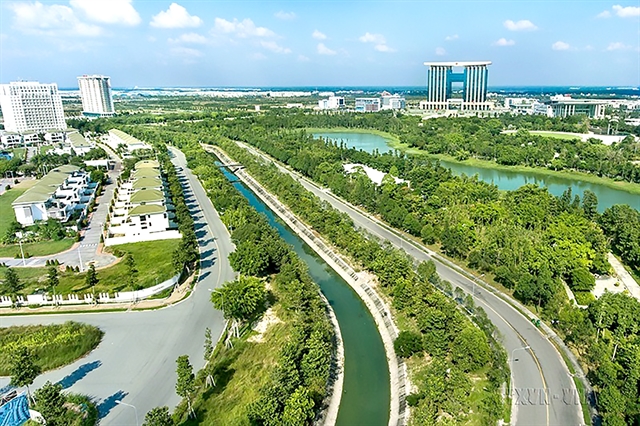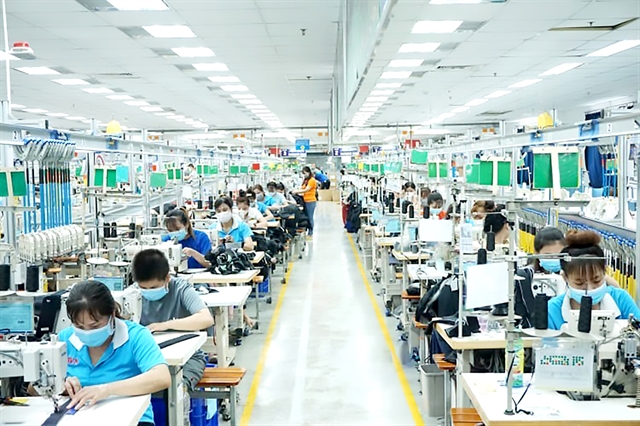
BÌNH DƯƠNG — Located in the southern key economic region, Bình Dương Province has become a model for attracting investment, industrialisation and urbanisation.
Since being re-established 25 years ago, with the goal of building the province to become a modern industrial centre and smart city of the southeast region, Bình Dương has been striving to improve the quality of human resources and enhance technology and infrastructure, helping the province continue becoming an attractive destination for strategic investors.
Human resources
In recent years, policies of attracting, training and fostering high-quality human resources have made Bình Dương a hotspot for workers from around Việt Nam to join its labour market, creating young and abundant human resources.
This is an opportunity to help the province have a developed economy.
So far, Bình Dương has 41 industrial zones, attracting nearly 42,300 domestic enterprises and over 3,750 foreign-invested projects.
The province has over 1.3 million employees, of whom 85 per cent are from other provinces and cities.
The average income of workers is currently VNĐ152 million (US$6,600) per person per year – among the top in the country.
Appreciating the policies on human resource development that are contributing to socio-economic development in the province, Associate Professor Phạm Ngọc Trâm, director of the Institute for Strategic Development Strategy under the Thủ Dầu Một University, said that Bình Dương had rationally and synchronously implemented many solutions to develop human resources.
Leaders of the province said that it has many projects to attract and improve the labour force’s qualifications.
These are the following projects: improving the quality of human resources in the period 2011-15; improving the quality of leaders, managers and scientific and technical workers in the period 2016-20; ensuring a skilled workforce for the period 2018-20, with a vision of 2025.
Currently, 100 vocational schools in the province have enrolled about 30,000 students, bringing the province’s vocational training rate to 80.5 per cent.
Bình Dương has also developed a smart city project to become one of the leading provinces in the country with global competitiveness in attracting, training and developing scientific and technical talents.
It builds experimental centres creating conditions for the development of new creative ideas, helping Bình Dương have a talented and high-quality workforce.
From the perspective of a school, PhD Hà Thúc Viên, deputy principal of the Việt Nam-Germany University, said that the university had trained about 3,000 quality students based on German and European standards.
It focuses on training human resources in two groups: training master students and training management capacity for the business sector.
The university pays attention to innovating teaching and learning equipment, accessing new technologies in industrial production and ensuring high-quality human resources for businesses in Bình Dương and provinces and cities in the southern key economic region.
Challenges
Professor Trần Thọ Đạt, member of the Central Theoretical Council and member of the Prime Minister’s Economic Advisory Group, analysed that to continue developing Bình Dương needed to find new growth methods to create higher productivity.
One of the new growth resources that are sustainable, environmentally friendly and keeping up with the trend of the times is the digital economy, in which, humans are the key factor. It requires human resources to have higher qualifications and understanding skills in applying new technologies and solving data problems of the digital economy production mode.
PhD Trần Minh Đức, from the Thủ Dầu Một University, said that the province still lacks high-skilled workers. Ninety per cent of businesses found it difficult to recruit highly-qualified workers after improving technology and investing a lot in equipment.
Looking at the employment structure in Bình Dương, the group of leaders and high-level technical workers still account for a low and relatively low proportion.
Statistics show that between 2016 and 2020, the leader group accounted for 0.9 per cent and the high-level technical workers accounted for 0.78 per cent. The group of personal services, security, craftsmen assemblers and mechanics account for over 90 per cent.
Workers quitting their jobs after being trained is also a concern of many businesses.
Workforce improvement

High-quality human resources are an important factor in helping Bình Dương catch up and integrate into the international economy in the new era.
Standing deputy secretary of the Bình Dương Provincial Party Committee Nguyễn Hoàng Thao said the province’s development direction until 2030 was to focus on developing high-tech industry, being environmentally friendly focusing on planned industrial zones.
The province also focuses on attracting domestic investment in supporting industries, providing raw materials for large corporations and participating in the global value chain of multinational corporations.
To reach the targets, from 2020 to 2022, the province has focused on developing policies to attract professional managers, good experts, and high-tech workers. It trains human resources with expertise and high professionalism.
Concerned units diversify and expand forms of cooperation, updating professional knowledge and practical skills.
Deputy Chairman of the Bình Dương People’s Committee Nguyễn Văn Dành said that the province has continued to develop human resource training programmes suitable for each group of people. For example, with high school students, it will improve the quality of education; with students of universities and colleges, it will improve training efficiency suitable for business needs, especially high-tech enterprises; with workers, it will improve high skills.
By 2025, Bình Dương is aiming for 85 per cent of workers to have received vocational training and to create jobs for about 35,000 workers per year.
Speaking about the resolution for further and sustainable development, Nguyễn Văn Quang, an expert from the Việt Nam Institute for Development Strategies under the Ministry of Planning and Investment, said that the government and local authorities played a key role in leading and creating an environment for technology development, digital transformation and digital economy.
Authorities also need to promote the central role of enterprises in investment activities, digital transformation and adaptation in all production activities.
Each employee needed to be proactive and integrated into mastering digital technologies and quickly adapt to technology changes.
The synchronous coordination of these roles will contribute to the development of high human resources in Bình Dương Province, to take advantage of opportunities and solve challenges in the context of the digital economy, said Quang.
Director of the Bình Dương Department of Education and Training Nguyễn Thị Nhật Hằng said that in the period 2021-25, the provincial education sector would improve the quality of the workforce.
The sector proposed the provincial people’s committee issue plans to attract talents and have supportive policies for students in educational universities and colleges.
Bình Dương has also gradually taught natural science subjects in English at all levels. It will also establish the Bình Dương Smart Education Operations Centre.
Region development
Standing Deputy Secretary of the Bình Dương Provincial Party Committee Nguyễn Hoàng Thao said that, as it is located in the southern key economic region, Bình Dương had many advantages for comprehensive socio-economic development.
Thanks to innovations in development, Bình Dương has become one of the four provinces and cities of the “nuclear quadrangle” (along with HCM City, Đồng Nai and Bà Rịa-Vũng Tàu). The quadrangle plays a decisive role in the economic strength of the whole region.
PhD Trần Du Lịch, a member of the Prime Minister’s Economic Advisory Group, emphasised that it was necessary to put the development of Bình Dương Province in the perspective of the regional economy, especially the “nuclear quadrangle” of the southern key economic region.
In order to create new dynamics and reach the goal of sustainable development, it is necessary to think about regional economic development, through linkages such as arranging production forces through regional planning, exploiting the strength of training of the HCM City National University and other training centres in the region, and develop the general labour market of the region. — – VnExpress News
- Reduce Hair Loss with PURA D’OR Gold Label Shampoo
- Castor Oil Has Made a “Huge” Difference With Hair and Brow Growth
- Excessive hair loss in men: Signs of illness that cannot be subjective
- Dịch Vụ SEO Website ở Los Angeles, CA: đưa trang web doanh nghiệp bạn lên top Google
- Nails Salon Sierra Madre
 VnExpress News The News Gateway of Vietnam
VnExpress News The News Gateway of Vietnam





